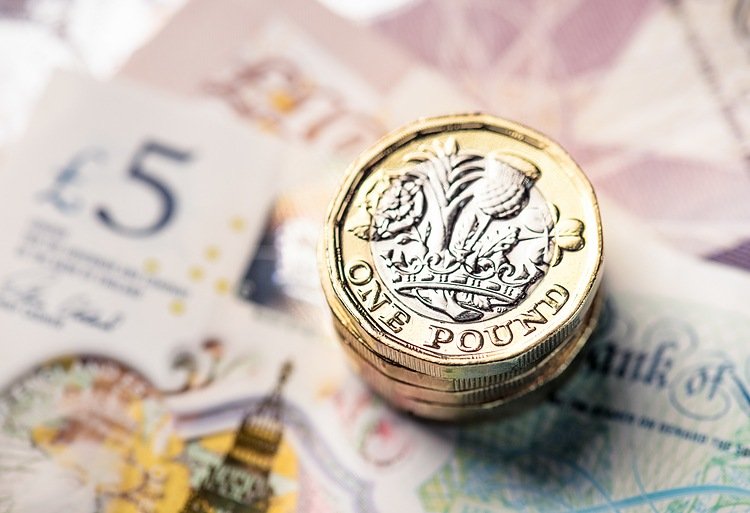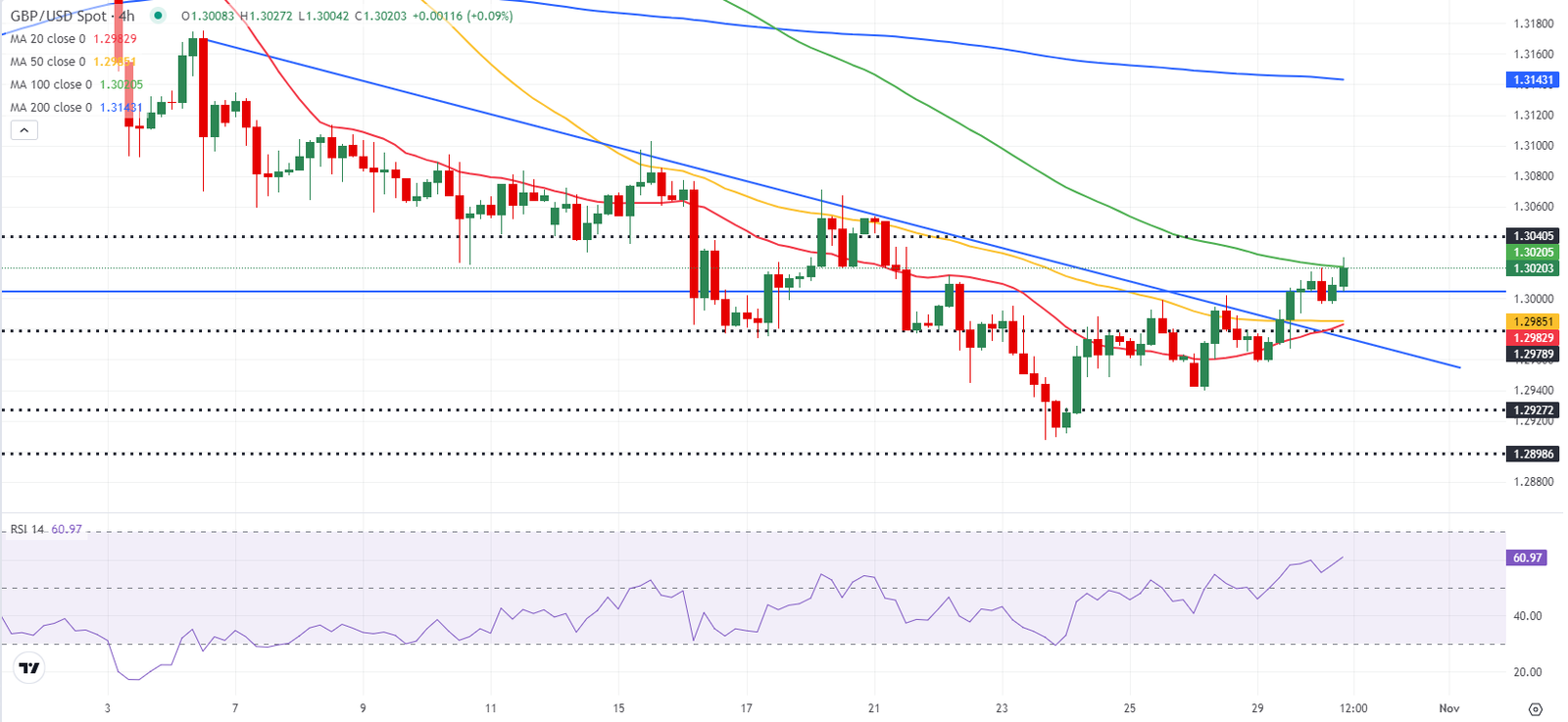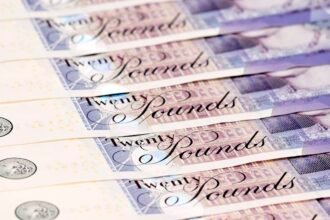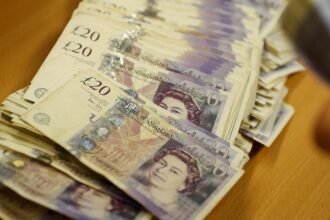- GBP/USD holds above 1.3000 in the European session on Wednesday.
- The UK government will announce the Autumn Budget.
- The US economic calendar will feature ADP Employment Change and Q3 GDP data.
Following Monday’s choppy action, GBP/USD gained traction and closed in positive territory on Tuesday. The pair stays in a consolidation phase above 1.3000 in the European session on Wednesday as market focus shifts to key macroeconomic data releases from the US and the UK budget announcement.
British Pound PRICE Today
The table below shows the percentage change of British Pound (GBP) against listed major currencies today. British Pound was the strongest against the US Dollar.
| USD | EUR | GBP | JPY | CAD | AUD | NZD | CHF | |
|---|---|---|---|---|---|---|---|---|
| USD | -0.26% | -0.02% | -0.21% | -0.04% | -0.30% | -0.40% | -0.09% | |
| EUR | 0.26% | 0.25% | 0.08% | 0.23% | -0.04% | -0.13% | 0.18% | |
| GBP | 0.02% | -0.25% | -0.16% | -0.02% | -0.29% | -0.38% | -0.05% | |
| JPY | 0.21% | -0.08% | 0.16% | 0.16% | -0.10% | -0.20% | 0.12% | |
| CAD | 0.04% | -0.23% | 0.02% | -0.16% | -0.27% | -0.36% | -0.03% | |
| AUD | 0.30% | 0.04% | 0.29% | 0.10% | 0.27% | -0.09% | 0.22% | |
| NZD | 0.40% | 0.13% | 0.38% | 0.20% | 0.36% | 0.09% | 0.32% | |
| CHF | 0.09% | -0.18% | 0.05% | -0.12% | 0.03% | -0.22% | -0.32% |
The heat map shows percentage changes of major currencies against each other. The base currency is picked from the left column, while the quote currency is picked from the top row. For example, if you pick the British Pound from the left column and move along the horizontal line to the US Dollar, the percentage change displayed in the box will represent GBP (base)/USD (quote).
UK Chancellor Rachel Reeves will unveil the Autumn Budget later in the day, which is expected to include tax rises and spending cuts.
Previewing the potential market reaction to the UK budget announcement, “Chancellor Reeves is expected to loosen fiscal policy somewhat and if she manages to pull that off and maintain credibility with investors, the GBP might benefit,” Scotiabank’s Chief FX Strategist Shaun Osborne said in a recently published report.
Meanwhile, the US economic calendar will offer the ADP Employment Change for October and the US Bureau of Economic Analysis’ first estimate of the third-quarter Gross Domestic Product (GDP) growth.
Investors see the employment in private sector rising by 115,000 following the 143,000 increase recorded in September. Additionally, the US’ GDP is forecast to expand at an annual rate of 3% in the third-quarter.
The USD could stay resilient against its rivals if these data arrive near or above market expectations and make it difficult for GBP/USD to push higher. On the other hand, mixed or disappointing data releases from the US could help the pair hold its ground. Nevertheless, it could be risky to bet on a direction in between the US data releases and the UK budget announcement.
GBP/USD Technical Analysis
GBP/USD rose above the descending trend line and the pair closed above the 100-day Simple Moving Average (SMA) on Tuesday. Additionally, the Relative Strength Index (RSI) indicator on the 4-hour chart rose slightly above 60, highlighting a buildup of bullish momentum.
On the upside, 1.3030 (20-day SMA) aligns as immediate resistance before 1.3100 (round level) and 1.3140 (50-day SMA). In case the pair falls below 1.3000 (round level, static level) and starts using this level as resistance, 1.2970 (100-day SMA) could be seen as next support ahead of 1.2900 (static level).
Pound Sterling FAQs
The Pound Sterling (GBP) is the oldest currency in the world (886 AD) and the official currency of the United Kingdom. It is the fourth most traded unit for foreign exchange (FX) in the world, accounting for 12% of all transactions, averaging $630 billion a day, according to 2022 data. Its key trading pairs are GBP/USD, also known as ‘Cable’, which accounts for 11% of FX, GBP/JPY, or the ‘Dragon’ as it is known by traders (3%), and EUR/GBP (2%). The Pound Sterling is issued by the Bank of England (BoE).
The single most important factor influencing the value of the Pound Sterling is monetary policy decided by the Bank of England. The BoE bases its decisions on whether it has achieved its primary goal of “price stability” – a steady inflation rate of around 2%. Its primary tool for achieving this is the adjustment of interest rates. When inflation is too high, the BoE will try to rein it in by raising interest rates, making it more expensive for people and businesses to access credit. This is generally positive for GBP, as higher interest rates make the UK a more attractive place for global investors to park their money. When inflation falls too low it is a sign economic growth is slowing. In this scenario, the BoE will consider lowering interest rates to cheapen credit so businesses will borrow more to invest in growth-generating projects.
Data releases gauge the health of the economy and can impact the value of the Pound Sterling. Indicators such as GDP, Manufacturing and Services PMIs, and employment can all influence the direction of the GBP. A strong economy is good for Sterling. Not only does it attract more foreign investment but it may encourage the BoE to put up interest rates, which will directly strengthen GBP. Otherwise, if economic data is weak, the Pound Sterling is likely to fall.
Another significant data release for the Pound Sterling is the Trade Balance. This indicator measures the difference between what a country earns from its exports and what it spends on imports over a given period. If a country produces highly sought-after exports, its currency will benefit purely from the extra demand created from foreign buyers seeking to purchase these goods. Therefore, a positive net Trade Balance strengthens a currency and vice versa for a negative balance.






















